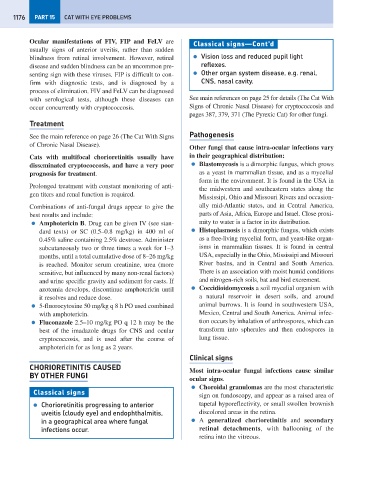Page 1184 - Problem-Based Feline Medicine
P. 1184
1176 PART 15 CAT WITH EYE PROBLEMS
Ocular manifestations of FIV, FIP and FeLV are
Classical signs—Cont’d
usually signs of anterior uveitis, rather than sudden
blindness from retinal involvement. However, retinal ● Vision loss and reduced pupil light
disease and sudden blindness can be an uncommon pre- reflexes.
senting sign with these viruses. FIP is difficult to con- ● Other organ system disease, e.g. renal,
firm with diagnostic tests, and is diagnosed by a CNS, nasal cavity.
process of elimination. FIV and FeLV can be diagnosed
with serological tests, although these diseases can See main references on page 25 for details (The Cat With
occur concurrently with cryptococcosis. Signs of Chronic Nasal Disease) for cryptococcosis and
pages 387, 379, 371 (The Pyrexic Cat) for other fungi.
Treatment
See the main reference on page 26 (The Cat With Signs Pathogenesis
of Chronic Nasal Disease).
Other fungi that cause intra-ocular infections vary
Cats with multifocal chorioretinitis usually have in their geographical distribution:
disseminated cryptococcosis, and have a very poor ● Blastomycosis is a dimorphic fungus, which grows
prognosis for treatment. as a yeast in mammalian tissue, and as a mycelial
form in the environment. It is found in the USA in
Prolonged treatment with constant monitoring of anti-
the midwestern and southeastern states along the
gen titers and renal function is required.
Mississipi, Ohio and Missouri Rivers and occasion-
Combinations of anti-fungal drugs appear to give the ally mid-Atlantic states, and in Central America,
best results and include: parts of Asia, Africa, Europe and Israel. Close proxi-
● Amphotericin B. Drug can be given IV (see stan- mity to water is a factor in its distribution.
dard texts) or SC (0.5–0.8 mg/kg) in 400 ml of ● Histoplasmosis is a dimorphic fungus, which exists
0.45% saline containing 2.5% dextrose. Administer as a free-living mycelial form, and yeast-like organ-
subcutaneously two or three times a week for 1–3 isms in mammalian tissues. It is found in central
months, until a total cumulative dose of 8–26 mg/kg USA, especially in the Ohio, Mississipi and Missouri
is reached. Monitor serum creatinine, urea (more River basins, and in Central and South America.
sensitive, but influenced by many non-renal factors) There is an association with moist humid conditions
and urine specific gravity and sediment for casts. If and nitrogen-rich soils, bat and bird excrement.
azotemia develops, discontinue amphotericin until ● Coccidioidomycosis a soil mycelial organism with
it resolves and reduce dose. a natural reservoir in desert soils, and around
● 5-fluorocytosine 50 mg/kg q 8 h PO used combined animal burrows. It is found in southwestern USA,
with amphotericin. Mexico, Central and South America. Animal infec-
● Fluconazole 2.5–10 mg/kg PO q 12 h may be the tion occurs by inhalation of arthrospores, which can
best of the imadazole drugs for CNS and ocular transform into spherules and then endospores in
cryptococcosis, and is used after the course of lung tissue.
amphotericin for as long as 2 years.
Clinical signs
CHORIORETINITIS CAUSED Most intra-ocular fungal infections cause similar
BY OTHER FUNGI
ocular signs.
● Choroidal granulomas are the most characteristic
Classical signs
sign on fundoscopy, and appear as a raised area of
● Chorioretinitis progressing to anterior tapetal hyporeflectivity, or small swollen brownish
uveitis (cloudy eye) and endophthalmitis, discolored areas in the retina.
in a geographical area where fungal ● A generalized chorioretinitis and secondary
infections occur. retinal detachments, with ballooning of the
retina into the vitreous.

